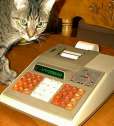Privileg SR-12PR
| Datasheet legend
Ab/c:
Fractions calculation
AC: Alternating current BaseN: Number base calculations Card: Magnetic card storage Cmem: Continuous memory Cond: Conditional execution Const: Scientific constants Cplx: Complex number arithmetic DC: Direct current Eqlib: Equation library Exp: Exponential/log functions Fin: Financial functions Grph: Graphing capability Hyp: Hyperbolic functions Ind: Indirect addressing Intg: Numerical integration Jump: Unconditional jump (GOTO) Lbl: Program labels LCD: Liquid Crystal Display LED: Light-Emitting Diode Li-ion: Li-ion rechargeable battery Lreg: Linear regression (2-var. stats) mA: Milliamperes of current Mtrx: Matrix support NiCd: Nickel-Cadmium recharg. batt. NiMH: Nickel-metal-hydrite rech. batt. Prnt: Printer RTC: Real-time clock Sdev: Standard deviation (1-var. stats) Solv: Equation solver Subr: Subroutine call capability Symb: Symbolic computing Tape: Magnetic tape storage Trig: Trigonometric functions Units: Unit conversions VAC: Volts AC VDC: Volts DC |
| ||||||||||||||||||||||||||||||||||||||||||||||||||||||||
Privileg SR-12PR
 Privileg, the store brand of the German store chain Quelle, offered many interesting calculators over the years. Like Radio Shack/Tandy in North America, Privileg repackaged a variety of calculator models under its own OEM brand. In fact, next to Radio Shack, Privileg is probably the second most prolific OEM brand of programmable calculators.
Privileg, the store brand of the German store chain Quelle, offered many interesting calculators over the years. Like Radio Shack/Tandy in North America, Privileg repackaged a variety of calculator models under its own OEM brand. In fact, next to Radio Shack, Privileg is probably the second most prolific OEM brand of programmable calculators.
The SR-12PR is Privileg's model number for a popular scientific calculator also known as the Citizen SRP-175 or the Canon F-800P. A true multifunction scientific model, the SR-12PR does just about everything you'd want from a decent engineering tool, with one huge exception: it is not possible to view/edit programs in its 128-step program memory, making program entry and modification needlessly difficult.
One clumsy feature of these machines' programming model is the way jump instructions are implemented: they only let you skip up to 9 program steps, forward or backward, in program memory. If your program requires that you skip over more steps, which is often the case, repeated use of GOTO is necessary. This is well illustrated in the following programming example, which computes the incomplete Gamma function. (To use this program, first place the integration limit in register 0, then enter the argument, and hit RUN 6):
01: STO 02: 2 03: RCL 04: 0 05: STO 06: 1 07: yx 08: RCL 09: 2 10: ÷ 11: RCL 12: 1 13: ex 14: ÷ 15: RCL 16: 2 17: = 18: STO 19: 3 20: STO 21: 0 22: 1 23: STO 24: + 25: 2 26: RCL 27: 1 28: GOTO 1 29: GOTO -9 30: ÷ 31: RCL 32: 2 33: × 34: RCL 35: 3 36: GOTO 1 37: GOTO -8 38: + 39: STO 40: 3 41: RCL 42: 0 43: = 44: x<=M 1 45: GOTO -8 46: RCL 47: 1 48: x<->M


